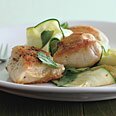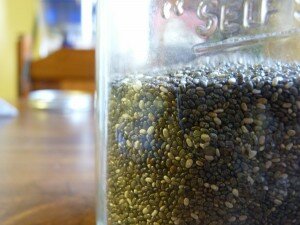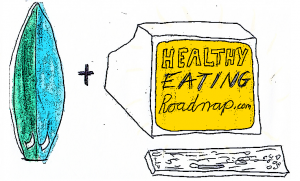Are Chia Seeds Good For You?
I’ll admit that I quickly became excited about chia seeds when they first entered my world. I did a bit of research after reading about them in Born To Run, and got excited about this newly discovered supposedly excellent source of Omega-3 fatty acids.
I ordered a big bag off Amazon.com and started incorporating some into smoothies and otherwise eating them by the spoonful. Recommending them to family and friends, I was a major chia fan to say the very least.
If you’ve never heard of chia seeds, here is a quick rundown:
- They were a major food source of the Mayan and Aztec civilizations
- They ARE the same seeds that grow chia pets (just don’t eat these ones, they’re processed differently)
- They are very high in Omega 3 fatty acids (even higher than flax seeds)
- They are becoming BIG TIME popular with a mention on Oprah by Dr. Oz
- Hold approx. 12 times their weight in water, and thereby aid in hydration
- High in antioxidants
A one ounce serving contains approximately:
- Omega-3 fatty acids: 5g
- Omega-6 fatty acids: 1.6g
- Fiber: 11g (primarily soluble) – total carbs 12g
- Protein: 4g
- Calories: 137
- Calcium: 180 mg
Pretty good stats right?
These stats are great for such an inexpensive food, but they don’t form the complete picture. Much like flaxseeds, the Omega-3 fatty acids contained in chia seeds are in alpha-linolenic acid (ALA) form. Herein lies the problem. The main benefits of Omega-3 ALA consumption is to try and get our bodies to convert it into EPA/DHA fatty acids (the kind found in fish oil), but in most cases our bodies just don’t seem to be efficient at making the conversion (sources: 1,2,3). ALA bio-conversion to EPA is very limited and conversion to the even more important DHA is practically absent. I said “in most cases” because there has been some evidence of the conversion rate being higher in vegans and EPA conversion higher in chronically-ill African-Americans (sources: 1,2).
To put all this more simply: most of the Omega-3’s we get from chia seeds get wasted.
Getting enough of the right (EPA/DHA) Omega-3 fatty acids is extremely important for overall good health – one of the most important dietary things you can do in my opinion. In order to reduce chronic inflammation, we should try to get closer to a 1:1 ratio of Omega-6 to Omega-3 fatty acids. This is vitally important. Most of us get far too much Omega-6 fatty acids, with the typical American’s ratio more around 30:1.
What does all this mean for you?
Most people should be supplementing with Omega’s 3’s to get the O6 to O3 ratio closer to 1:1. And as long as your not vegetarian/vegan, you probably should be taking fish-oil instead of relying on chia seeds. Chia seeds (or flax seeds) just can’t give you the proper Omega-3 benefits.
That being said, I’m going to recommend you still eat them, but for different reasons than you’ve previously heard. Chia seeds are mainly a good food option for their high content of soluble fiber and antioxidants as well as their hydrating properties (when prepared as a gel). So yeah…don’t give up on them just yet!
–
Any questions? Leave a comment and I’ll be sure to respond. If you haven’t already – please subscribe so you don’t miss out on more healthy eating tips in the future.
Recipe: Chicken Breast Zucchini Pappardelle
 If you want something light and refreshing to eat for dinner then you’ve got to give this a try. I made it last night…its amazing and very easy!
If you want something light and refreshing to eat for dinner then you’ve got to give this a try. I made it last night…its amazing and very easy!
Serves 2
Start to finish- 25 minutes
Ingredients:
- 1/2 lb zucchini
- 1 garlic cloves
- 2 boneless skinless chicken breast halves
- 1/2 Tbsp olive oil
- 1 Tbsp water
- 1/2 cup torn basil leaves
- Accompaniment: Lemon Wedges
Directions: Shave zucchini lengthwise with carrot peeler or slicer and put in a large bowl. Thinly slice garlic and reserve separately. Pat chicken dry, then cut crosswise into thirds. Season chicken all over with 1/4 tsp salt and 1/4 tsp pepper. Heat oil in a skillet over medium-high heat until it shimmers. Saute chicken until golden brown about 8-14 minutes. Add chicken to the bowl of zucchini. Then add garlic to skillet and cook until pale golden, about 1 minute. Add the 1 Tbsp water to skillet and scrape up any brown bits, then drizzle over chicken and zucchini. Add basil and 1/8 tsp salt to bowl and toss until zucchini wilts slightly. Season with salt and pepper.
Enjoy!!
4 unconventional tips for healthier eating
Written by Michelle Nardine RD. Follow me on Twitter.

We’ve been told a million times to eat more fruits and vegetables and reduce processed carbs and sugars. Oftentimes, healthy eating advice can be boring and ineffective. What follows are four actionable ideas that are not conventionally preached as eating advice. Some may even help you save a buck.
1. Get Smaller Plates
The main reason people gain weight is by simply eating too much. We forget to watch our portion size. Although I definitely don’t advocate fast food, an interesting video documentary by James Painter called Portion Size Me proved that even a 30 day diet of nothing but fast food can make you lose weight and lower cholesterol. The key is proper portions.
Want to automatically trick yourself into eating less food? Get smaller plates. Brian Wansink, author of Mindless Eating: Why We Eat More Than We Think, refers to studies that show you eat less food with smaller plates. The average plate size in America has been steadily increasing since the early 80’s, resulting in national weight gain.
To get back to the way things should be, get yourself some nice 8-10 inch diameter dinner plates and donate the big ones in your cupboard to your local charity or throw them off train tracks (I’m kidding, I swear!).
2. Start Gardening
Most everything that comes out of a garden is healthy and delicious. You will be eating the freshest food on the planet resulting in a maximum amount of nutrients.
And BONUS- you will be saving money! According to Vegetable Gardening for Dummies, a garden that is 20 feet by 30 feet requires an initial investment of $70 for things like seeds and soil, and produces more than $600 worth of vegetables over the course of a season.
There are several ways to get started depending on your situation. You can start small by potting plants in containers on your porch or just growing herbs from your kitchen window. Take it up a notch by creating raised beds in your backyard or at a friend’s house. You might also look into joining a community garden, where you’re sure to get expert advice and meet friendly neighbors. You can find more tips and links in my article “How to Start Gardening“.
3. (Beef Eaters) Organize a Cow Share
If you’re a beef eater who has seen documentaries such as Food, Inc that expose the horrors of factory farming, you’re probably interested in getting more of your beef from local farms raising animals on fresh pasture. You may also have noticed that grass-fed beef is more expensive.
For some, the high price of grass-fed can be beneficial by causing you to rely more on fruits and vegetables. For many people however, it’s a deterrent which causes them instead to choose factory farmed beef that’s higher in saturated fat and lower in good fats and omega-3s. To make the switch to grass-fed without killing your wallet, buy in bulk.
Get a few friends together who prefer grass-fed and go in on a whole or half cow from a local farm and store it in your freezer. With whole butchered cows typically selling for less than $3.00 a pound, you can stand to save a lot of money over time. Visit eatwild.com to find an ethical farming operation in your area.
4. Read a Compelling Book
Sometimes, a well-written compelling story is needed to drive a point home and solidify it in our minds. Over time, these ideas can turn into habits that shape our actions. I think one easy way to eat better is to read about healthy food and the surrounding industries. Here are 4 books you might consider to get started:
- Good Calories, Bad Calories by Gary Taubes. Great information! If you haven’t already, check out Darya’s thorough review of this life changing book.
- The Omnivores Dilemma by Michael Pollan. One of the most talked about food books of the last few years and for good reason. A beautifully written book that is part policy and all heart.
- In Defense of Food: An Eater’s Manifesto by Michael Pollan. This is a great follow up to The Omnivores Dilemma, loaded with fascinating information I hadn’t a clue about.
- Mindless Eating: Why We Eat More Than We Think by Brian Wansink, Ph.D. It shows why you might not realize how much you’re eating, what you’re eating, or even why you’re eating.
–
Subscribe to this blog so you don’t miss a future post on the new hobby I call “Salad Hiking”.
photo by cliff1066
Nerd Surfing: April 2019
Here are some neat, hilarious, healthy, awesome, or interesting things I found while on the nerdbox surfing around the web the last couple months.
Bored or want to procrastinate on your creative projects for a little longer? Click around and see what you find. Some things deal with healthy food and some are just straight up random.
Food Stuff:
First, these two blog posts could just change your life:
- turn frozen banana’s into an amazing (ice-cream craving killing) healthy treat
- Making perfect burger’s this week? You can’t go wrong with a side of life-changing fries!
Honeymoon planning is super fun! This AWESOME breakfast pizza recipe was adapted from a bakery in Big Sur, CA that we’ll be visiting during our honeymoon in September (so excited!).
For desert, this is about as healthy as amazingly delicious brownies get: Almond Butter Pumpkin Brownies (only 5 ingredients!!)
I know lots of people reading this are either curious about or probably drink kombucha tea. We brew it here at home so this article (even though important) made me a little sad. (hat-tip to Gina at Candid RD)
Meat….
- Best and Worst Seafood Choices
- Advantages of Grass-Fed Beef
- Wondering if you should eat bacon? (haha!!!)
If you want, we would love to have you chime in on our discussion on wholeliving.com about “What’s the hardest part of Eating Healthy?“ Lots of great responses so far…
Here is the Greek’s secret to longevity: cook amazing dishes like this Green’s Pie (video) and share it with your friends and family (ohh, and drink plenty of red wine too).
Straight Up Random Stuff:
Thinking about having kids? Your going to want to teach them how to tie their shoelaces this way so they can be the coolest kids in their class. And make sure to stay organized with this incredibly simple online to-do list.
(Interesting) Get rid of your car, pull your kids out of school, and cancel your cable TV. On a re-imagined society:
- http://mnmlist.com/reimagined/
- http://www.farbeyondthestars.com/?p=1525
- What do you think??? Leave a comment!
OK, that’s it for now. I hope I didn’t make you procrastinate on your projects for too long. I think maybe you should read this one last article.
Have a great week everyone! Love, Michelle














